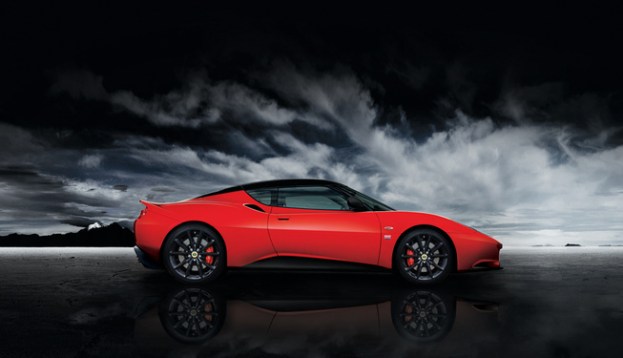 Since Lotus Cars’ lineup of sports cars is down to three models (just one in the United States) it’s probably a good thing that the company is building a new variant to broaden appeal as much as possible. The Evora Sports Racer’s name alone sounds exciting, so the Hethel, England-based company is already off to a good start.
Since Lotus Cars’ lineup of sports cars is down to three models (just one in the United States) it’s probably a good thing that the company is building a new variant to broaden appeal as much as possible. The Evora Sports Racer’s name alone sounds exciting, so the Hethel, England-based company is already off to a good start.
Lotus is actually pitching the Sports Racer as a more premium alternative to the base Evora and Evora S, not as a hardcore, well, racer.
The two-tone color scheme definitely looks classy. The Evora Sports Racer is available in Aspen White, Carbon Gray, Nightfall Blue, and Ardent Red, all with gloss black mirrors, wheels, and roof.
The two-tone theme continues on the inside, where red leather upholstery with black stitching, or black leather with red stitching, are the only options. The Evora Sports Racer also comes standard as a 2+2, with tiny rear seats that are an option on other Evoras. The rear seats are more like child seats, though.
The Sports Racer comes with the same 3.5-liter Toyota Camry V6 as the Evora and Evora S. It can be ordered as either a standard Evora with 276 horsepower, or as a supercharged S with 345 hp.
Impressive name aside, the Sports Racer is starting look like a typical automotive special edition: plenty of fancy graphics, but nothing substantial to make it truly special. That’s true, until you look at the options list.
The Evora Sports Racer isn’t a racer, it’s a fully-loaded Evora, with every option box checked. It comes with a seven-inch touch screen, DVD player, Bluetooth and USB connectivity, a rearview camera, and rear parking sensors. These items are all part of the optional Tech Package on standard Evoras.
This would all be standard fare on a Porsche 911 or BMW M3, but the typical Lotus buyer doesn’t automatically load their car with tech. Lotus founder Colin Chapman said the best way to build a car was to “simplify, and add lightness.” That means eliminating anything that doesn’t make the car better to drive.
By loading a car with tech and packaging it as a distinct trim level, Lotus seems to be appealing to less hardcore buyers who want a sports car that is fun to drive, but is also comfortable and practical. Porsche figured this out a long time ago, which is why it is financially stable, while Lotus is always in financial jeopardy.
The Evora Sports Racer is on sale right now in Europe for about $94,500. That’s a big jump from the $66,100 base Evora and the $76,100 Evora S but, as with Porsche’s Boxster, the options seem to add up quickly. Lotus did not say whether the Sports racer will be sol in the U.S. It seems like it has a decent chance, since the Evora is the only Lotus currently sold here.


